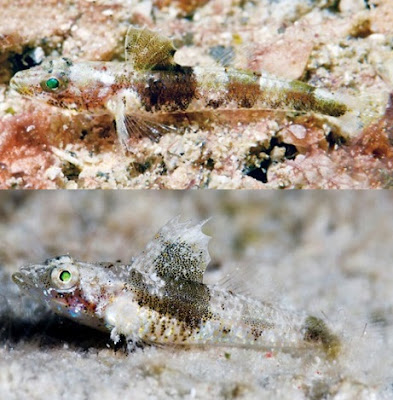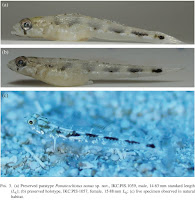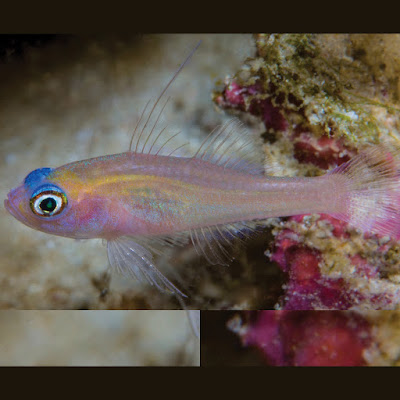| Palatogobius incendius Tornabene, Robertson & Baldwin, 2017 |
Abstract
A new species of deep-reef fish in the goby genus Palatogobius is described from recent submersible collections off Curaçao and Dominica. Video footage of schools of this species reveal predation by the invasive Indo-Pacific lionfish (Pterois spp.), the first record of undescribed fauna potentially being eaten by lionfish outside of its native range. We present molecular phylogenetic data for all valid species of Palatogobius and related genera, as well as a taxonomic key to the species of Palatogobius and a generic key to Palatogobius and related genera in the western Atlantic. Lastly, we discuss ecological and behavioral aspects of some deep-reef fishes in light of potential threats from invasive lionfish.
| Fig 2. Palatogobius incendius, live in aquarium, USNM 415430, 18.3 mm SL, Curacao. Photo by Barry Brown. |
Palatogobius incendius Tornabene, D. Ross Robertson & Baldwin, sp. nov.
Diagnosis: Side of body with yellow/orange stripe along lateral midline, stripe continuing onto and extending entire length of caudal fin; second dorsal fin I,14–16; anal fin I,14–17; pectoral fin 18–20; no teeth on vomer; body scales absent except for occasionally 2 to 3 cycloid scales on base of caudal fin; interorbital pore C absent; interorbital pores D paired; eye diameter 7.0–9.0% SL.
Etymology: The specific epithet incendius is an adjective formed from the Latin root incendium meaning ‘fire.’ The scientific and proposed common names refer to the bright orange, yellow and reddish-pink coloration on the body, head and fins.


| Fig 6. School of Palatogobius incendius at type locality, sta. CURASUB15-30, 152 m depth, Curacao. |
Habitat and distribution: Palatogobius incendius has been collected on deep reefs from Curacao (119–128 m) and Dominica (88–168 m) and observed off Roatan, Honduras (94–201 m). The species occurs exclusively in hovering schools ranging in size from as small as 5 to 10 individuals (rare) to 50->200 individuals (Fig 6). Schools are most frequently found at the top or bottom of vertical walls off Curaçao and Dominica, but off Roatan we observed more than a dozen schools of P. incendius collectively comprising as many as 1000 individuals over a long, gradually inclining stretch of sand and small rocks from ~150–170 m depth. Over this stretch, P. incendius co-occurred with many individuals of P. grandoculus, which were closer to the bottom rather than hovering well off the bottom like P. incendius. Schools of P. incendius generally comprise individuals at multiple life stages, ranging from moderately developed larvae (~9 mm SL) to adults. Off Dominica we also observed larger swarms of minuscule fish (~5 mm TL) that could possibly be very recently recruited P. incendius larvae, given their size, abundance and depth range. Individuals in these swarms were too small to be captured, and were observed traveling only a few cm off the bottom rather than hovering in a cloud well above the substrate. These schools of post-larvae were 1–2 m wide and up to 5 m long, and moved steadily upslope at approximately 0.15 m/s, navigating laterally around obstacles in a fashion superficially similar to a wide chain of marching army ants.
Luke Tornabene and Carole C. Baldwin. 2017. A New Mesophotic Goby, Palatogobius incendius (Teleostei: Gobiidae), and the First Record of Invasive Lionfish Preying on Undescribed Biodiversity. PLoS ONE. 12(5): e0177179. DOI: 10.1371/journal.pone.0177179
---------------------------------------------------------------
روابط التحميل والمشاهدة، الروابط المباشرة للتحميل
او
شاهد هذا الفيديو القصير لطريقة التحميل البسيطة
كيف تحصل على مدونة جاهزة بآلاف المواضيع والمشاركات من هنا
شاهد قناة منتدى مدونات بلوجر جاهزة بألاف المواضيع والمشاركات على اليوتيوب لمزيد من الشرح من هنا
رابط مدونة منتدى مدونات بلوجر جاهزة بآلاف المواضيع والمشاركات في أي وقت حــــتى لو تم حذفها من هنا
شاهد صفحة منتدى مدونات بلوجر جاهزة بألاف المواضيع والمشاركات على الفيس بوك لمزيد من الشرح من هنا
شاهد صفحة منتدى مدونات بلوجر جاهزة بألاف المواضيع والمشاركات على الفيس بوك لمزيد من الشرح من هنا
تعرف على ترتيب مواضيع منتدى مدونات بلوجر جاهزة بآلاف المواضيع والمشاركات (حتى لا تختلط عليك الامور) من هنا
ملاحظة هامة: كل عمليات تنزيل، رفع، وتعديل المواضيع الجاهزة تتم بطريقة آلية، ونعتذر عن اي موضوع مخالف او مخل بالحياء مرفوع بالمدونات الجاهزة بآلاف المواضيع والمشاركات، ولكم ان تقوموا بحذف هذه المواضيع والمشاركات والطريقة بسيطة وسهلة. ــــــــــــــــــــــــــــــــــــــــــــــــــــــــــــــــــــــــــــــسلامـ.























